Physical Address
304 North Cardinal St.
Dorchester Center, MA 02124
Physical Address
304 North Cardinal St.
Dorchester Center, MA 02124
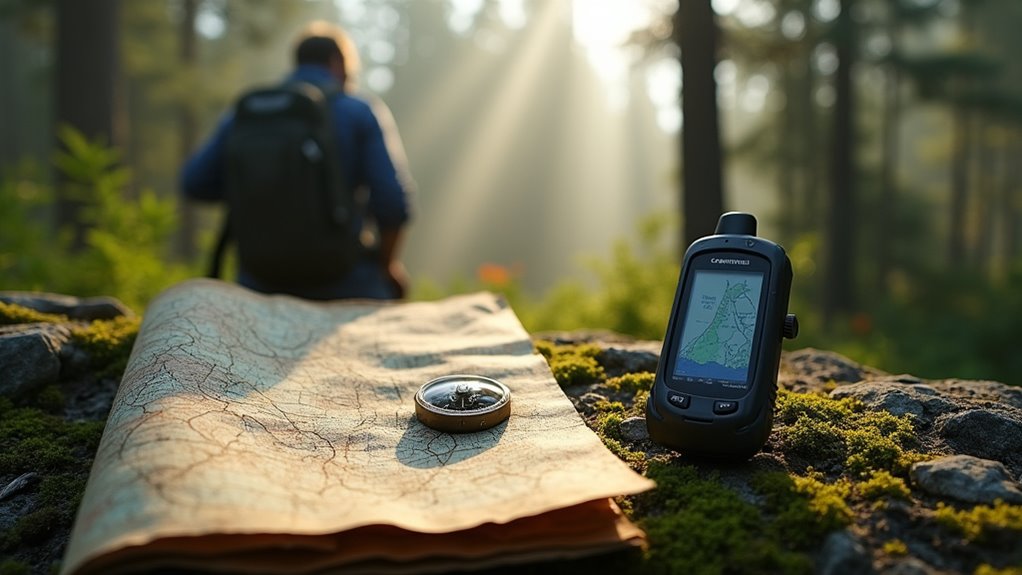
Discover why seasoned hikers still pack traditional navigation tools despite modern GPS technology—the answer might surprise you.
According to a recent survey by the National Park Service, 68% of lost hikers who relied solely on GPS devices had difficulties due to technical failures or dead batteries. You’ll find that choosing between GPS and traditional navigation tools isn’t just about convenience—it’s about your safety in the wilderness. While modern technology offers impressive features, the age-old reliability of maps and compasses presents compelling advantages. Let’s explore what experienced outdoors people have discovered about both methods before you make your next trail decision.
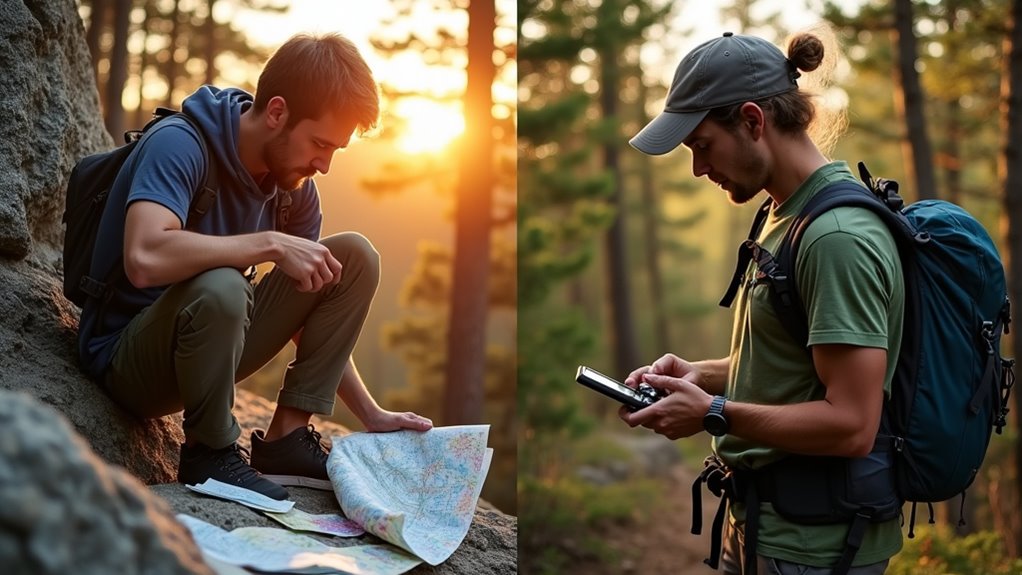
While GPS devices promise instant navigation gratification, traditional map and compass skills demand a more substantial investment of time and effort to master.
You’ll quickly grasp GPS basics within minutes, following turn-by-turn directions without much thought. However, this convenience comes at a cognitive cost.
Learning map and compass navigation requires dedicated practice to understand topographic symbols, magnetic declination, and bearing calculations. First 48 programming expeditions help build these foundational skills right from the start.
Yet these skills foster deeper environmental awareness and spatial memory that’ll serve you well in diverse conditions. You’ll develop essential problem-solving abilities as you navigate around obstacles and make real-time route adjustments.
While the learning curve is steeper, mastering traditional navigation methods builds self-reliance and lasting competence that won’t fail when technology does.
This fundamental skillset proves invaluable in remote areas where GPS signals are unreliable.
Although GPS technology has revolutionized navigation, its reliability in the wilderness faces significant challenges that traditional methods don’t encounter. Your GPS device depends on clear satellite signals, which can be blocked by dense forests, mountains, or canyons. Heavy storms and cloud cover can also interfere with signal accuracy. Location errors can range between 20 and 80 meters when using uncorrected GPS in challenging terrain.
GPS may be advanced, but dense forests, mountains, and bad weather can block satellite signals, making traditional navigation more dependable.
You’ll find that maps and compasses remain consistently reliable because they don’t rely on batteries, electronics, or external signals. They’re immune to environmental interference and continue working in any weather condition. Outdoor camping can expose GPS devices to water damage or battery failure, which would result in a loss of navigation.
While GPS devices can offer precise location data within 5-10 meters, they’re vulnerable to failure from dead batteries, water damage, or signal loss.
For your safety, it’s best to use GPS as a backup rather than your primary navigation tool. Map and compass skills provide reliable navigation that won’t let you down when technology fails.
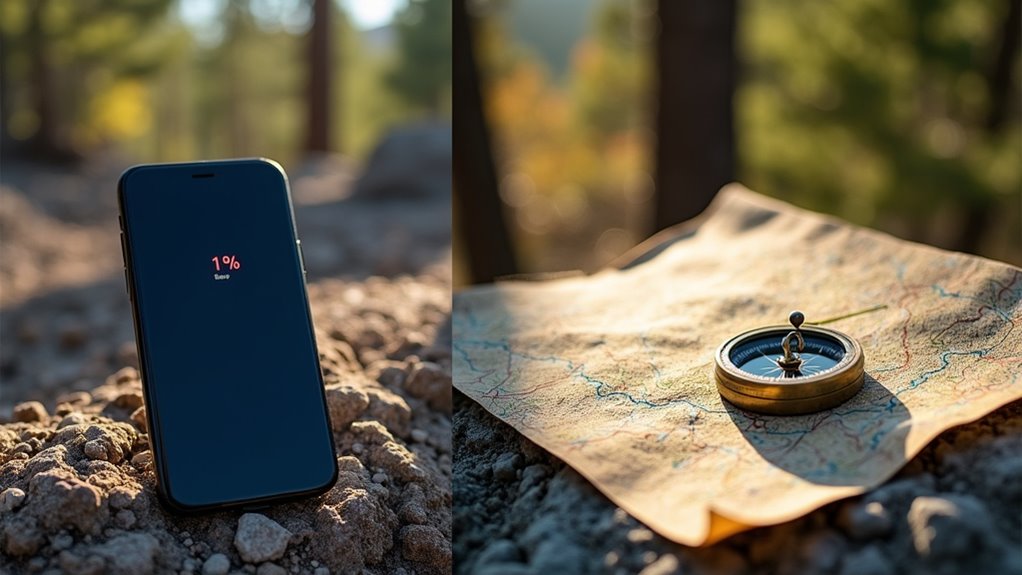
Because battery life remains a vital concern for GPS users in the wilderness, you’ll need to carefully consider power management during your adventures.
While modern GPS units can last up to 840 hours in power-saving modes, features like multi-band GNSS, messaging, and frequent screen use will drain your battery faster than expected. Cold temperatures can further reduce battery performance. The quad-helix antenna technology in modern GPS devices helps maintain reliable satellite connections even in challenging conditions.
In contrast, a compass and map never need batteries or recharging. You won’t have to carry spare batteries, portable chargers, or worry about power-related failures during extended trips. RV Camping is Better than Tent Camping, as it provides more reliable power sources for your GPS.
There’s no need for software updates, calibration, or technical setup – just pull them out and start steering. This reliability becomes especially essential when you’re deep in the backcountry where power sources are scarce and every ounce of pack weight matters.
Since adverse weather can challenge any navigation method, understanding how environmental conditions affect both GPS and traditional tools is essential for wilderness safety.
While GPS signals can struggle in heavy rain and dense forests, they’ll work fine through clouds and light precipitation. You’ll need a waterproof device for wet conditions.
Your compass and map combo offers more weather resilience, functioning regardless of rain or fog – though you’ll want waterproof maps or protective cases. The luminous markings on quality compasses like the Silva Expedition 4 ensure visibility even in dark stormy conditions.
However, nearby metallic objects and certain geological features can throw off compass readings. Proper survival gear can help mitigate the impacts of bad weather on your camping or hiking trip.
Both systems face unique terrain challenges: GPS signals get blocked in canyons and urban areas, while compass navigation becomes trickier in featureless landscapes.
For maximum reliability, consider using both methods – GPS for precision when conditions allow, and compass/map as your dependable backup in challenging environments.
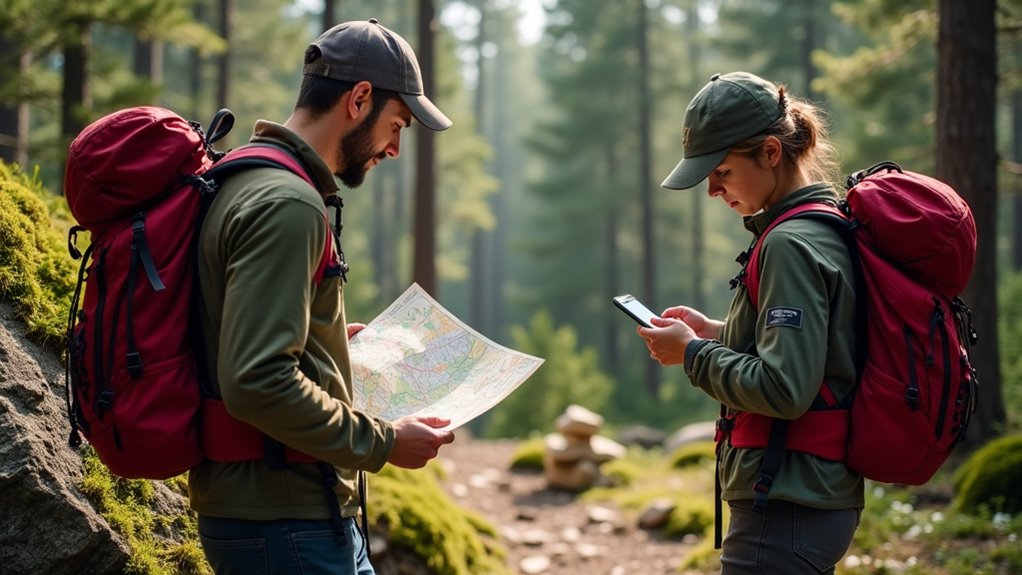
When comparing navigation accuracy and speed, both GPS and traditional methods offer distinct advantages.
You’ll find that GPS devices with WAAS/EGNOS can achieve accuracy within 3 meters and provide instant location updates without manual calculations. They’re particularly useful for quick rerouting and single-handed operation.
However, don’t underestimate traditional navigation – a well-practiced map and compass user can match GPS accuracy in most hiking scenarios. Choosing the right camping flashlight is also crucial for navigation in low-light conditions.
While compass navigation requires periodic checks and two-handed operation, it’s immune to signal loss issues that can affect GPS under dense forest canopy or in steep terrain. Knowing how to use a compass is essential since magnetic declination adjustments can significantly impact navigation accuracy over long distances.
The real difference lies in speed – GPS offers immediate location data and faster route plotting, while map and compass require manual calculations and physical reorientation.
For time-sensitive navigation, GPS holds a clear advantage.
Although both navigation methods require initial investment, you’ll find striking differences in their cost structures and long-term value.
Making the right navigation choice means looking beyond the price tag to understand true ownership costs and lasting benefits.
Basic compasses start under $10, while quality baseplate models range from $20-$40. In contrast, GPS devices typically cost $100-$300, with premium combo units exceeding $300.
Consider the long-term implications: your compass will remain reliable for years with minimal maintenance, while GPS units need regular battery changes, software updates, and potential repairs. Proper storage of compasses away from electronics helps ensure their longevity and accuracy.
You might also face technological obsolescence with GPS devices, requiring eventual replacement as newer models emerge. While GPS units offer valuable features like altimeters and digital mapping, they’re more vulnerable to environmental factors and water damage. Essential camping gear can provide added protection for your GPS device.
For budget-conscious outdoor enthusiasts, a quality compass provides exceptional value, offering reliable navigation without ongoing costs or technological dependencies.
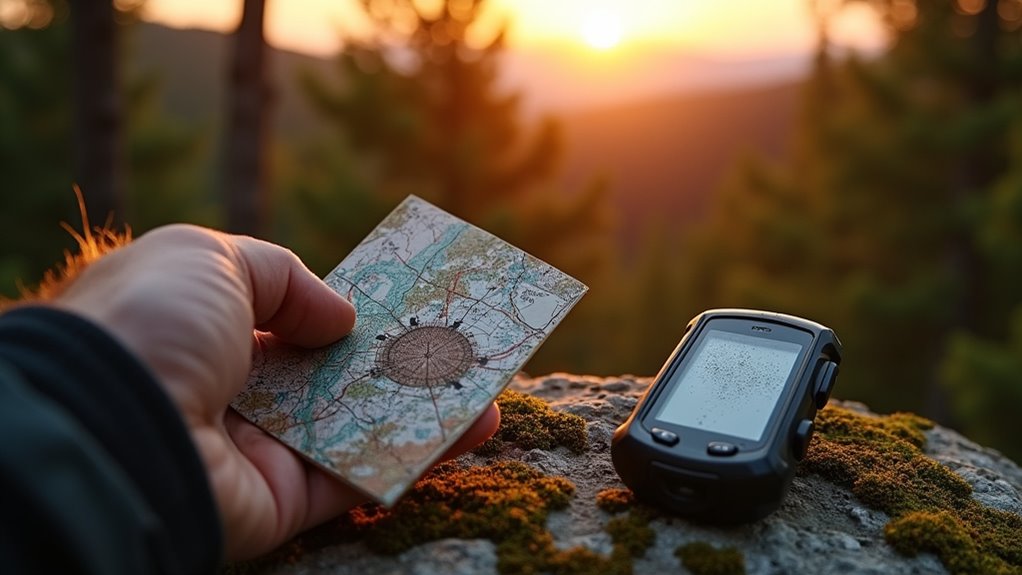
Despite their vast technological differences, traditional and modern navigation methods each bring unique advantages to outdoor exploration.
While GPS offers precise location data and real-time tracking with minimal training, maps and compasses provide reliable navigation without batteries or signal dependence. Camping off the grid is an important consideration when choosing navigation methods.
You’ll find that GPS devices excel in ease of use and quick decision-making, but they’re vulnerable to technical failures and dead batteries.
Traditional methods require more skill but won’t let you down when technology fails. Many experienced hikers combine both approaches, using GPS for precise coordinates while maintaining map-reading skills as a backup.
Consider learning both methods to enhance your outdoor competence. Practicing navigation in varied terrain conditions helps build proficiency and confidence for challenging situations.
Maps help you understand the broader terrain, while GPS can pinpoint your exact location.
This hybrid approach guarantees you’re prepared for any situation while maximizing the strengths of each system.
The most effective outdoor navigation combines GPS technology with traditional map and compass skills, creating a robust system that covers all scenarios. You should utilize both systems when hiking in complex terrain, dealing with poor visibility, or planning long-distance trips.
During pre-trip preparation, use your GPS to plot waypoints while studying your map’s topographic details. When you’re on the trail, let your GPS track your progress while using your map to identify landmarks and potential hazards. Understanding how to adjust for magnetic declination can prevent navigational errors when using both systems together.
This dual approach is especially valuable in emergencies – your GPS can pinpoint your location for rescue teams, while your map provides essential context about the surrounding area. Bringing a boat along on a camping trip can add another layer of complexity that further necessitates the use of both GPS and map/compass.
Remember to carry backup power for your GPS and keep your maps in waterproof protection. Cross-validate between both systems regularly to verify you’re on the right path.
Like two sides of the same coin, GPS devices and traditional navigation methods each bring unique strengths to your outdoor adventures. You’ll find the best approach is using both: GPS for quick coordinates and maps/compasses for reliable backup. While GPS technology offers convenience, don’t let your basic navigation skills rust away. Smart hikers embrace both tools, ensuring they’re never lost in today’s digital wilderness or tomorrow’s unplugged trails.